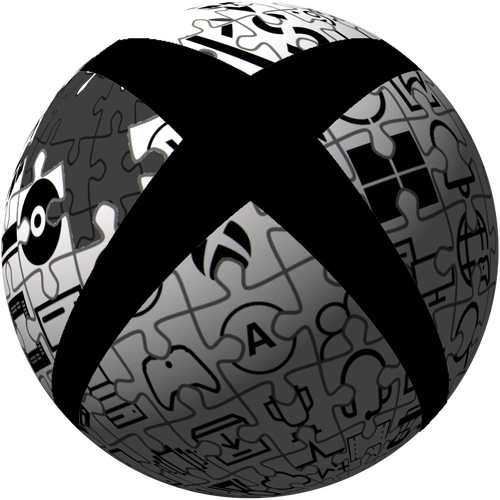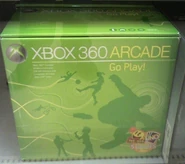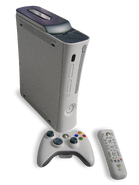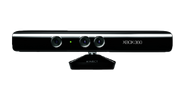| This article has encountered the Red Ring of Death!
This article has a few issues that need fixing. It may contain incorrect information or be formatted in a messy way. You can help Xbox Wiki by cleaning the article up and making sure it follows the edit poilcies. |
| “ | Jump In | ” |
—Slogan used at launch. | ||
The Xbox 360 is a seventh generation video game console developed by Microsoft. Released on November 22, 2005,[1] it is the successor to the original Xbox and is the second console in the Xbox family.
The Xbox 360 competed with Sony's PlayStation 3 and Nintendo's Wii as part of the seventh generation of video game consoles. It was officially unveiled on MTV on May 12, 2005, with detailed launch and game information announced later that month at the 2005 Electronic Entertainment Expo.
The Xbox 360's successor, the Xbox One was released on November 22, 2013.[2] On April 20, 2016, Microsoft announced that it would end the production of Xbox 360 hardware, although the company would continue to support the platform.[3]
History[]
Development[]
Known during development as Xenon, Xbox 2, Xbox FS,[4] Xbox Next, or NextBox, the Xbox 360 was conceived in early 2003.[5] In February 2003, planning for the Xenon software platform began, and was headed by Microsoft's Vice President J Allard.[5] That month, Microsoft held an event for 400 developers in Bellevue, Washington, to recruit support for the system.[5] Also that month, Peter Moore, former president of Sega of America, joined Microsoft. On August 12, 2003, ATI signed on to produce the graphic processing unit for the new console, a deal that was publicly announced two days later.[6] The following month, IBM agreed to develop the triple-core CPU for the console.[5] Before the launch of the Xbox 360, several "Alpha" development kits were spotted using Apple's Power Mac G5 hardware. The earliest known sighting of the Xbox 360 "Alpha" XeDK Power Mac units was in October 2003. This was due to the system's PowerPC 970/970fx CPU and ATI Radeon 9800 series GPU being similar to IBM's Xenon Processor and ATI's Xenos GPU, both of which were specifically designed for the Xbox 360. The Alpha XeDK units were eventually replaced by the "Beta" XeDK units, which were very similar to the Xenon model Xbox 360 released in 2005.
A major focus during the Xbox 360's development was security. The original Xbox suffered many security flaws in both hardware and software, leading to the quick exploitation of the machine to run unsigned programs such as Linux, play backups of Xbox game discs, and develop home made games. Because of this, the Xbox 360 was designed to be extremely secure from a software and hardware point of view. As stated by Chris Satchell in September 2005, "There are going to be levels of security in this box that the hacker community has never seen before." Many security improvements were made, many of which directly came about from the failures made on the original Xbox. The implementation of a Hypervisor, which is a small virtual machine that lives in the RAM, prevents unsigned code execution as well as tampering with the console's memory. Another vital security feature implemented was IBM's "eFUSE" technology, which is small fuses soldered onto the CPU die that was blown with every system update, preventing downgrading to a possible exploitable dashboard/kernel, as well as storing vital console information like the per-console CPU key. However, time would prove that the Xbox 360 was not nearly as secure as once thought, as by the beginning of 2006, exploits had been discovered that allowed pirated game backups to run from the DVD drive, as well as an exploit to bypass the all-seeing Hypervisor.
Release[]
The Xbox 360 launched world wide in November 2005, it was in short supply at one point in many regions, including North America and Europe.
The earliest versions of the console suffered from a high failure rate, indicated by the so-called "Red Ring of Death ", necessitating an extension of the consoles warranty period. It has been found that around 54% of all Xbox 360s suffered from the Red Ring of Death.
Throughout the Xbox 360's life, Microsoft released two redesigned models of the console- Xbox 360 S (2010) and Xbox 360 E (2013).
As of June 2014, 84 million Xbox 360 units had been sold world wide. In 2009 the Xbox 360 became the sixth best selling video game console in history, despite being outsold by the Nintendo Wii and PlayStation 3.
Hardware[]
Accessories[]
There are many accessories available for the console, including both wired and wireless controllers, faceplates for customization, headsets for chatting, a webcam for video chatting, three sizes of memory units and five sizes of hard drives (20, 60, 120, 250, and 320 GB), among other items, all of which are styled to match the console.
In 2006, Microsoft released the Xbox 360 HD DVD Player. It was discontinued in 2008 after the format war had ended in Blu-ray's favor.[7]
Kinect[]
Kinect is a "controller-free gaming and entertainment experience" for the Xbox 360. It was first announced on June 1, 2009, at the Electronic Entertainment Expo, under the codename Project Natal. The add-on enables players to control and interact with the Xbox 360 without a game controller by using gestures, spoken commands, and presented objects and images. The Kinect is compatible with all Xbox 360 models.
It was released on November 4, 2010.
Retail configurations[]
Launch[]
When the Xbox 360 was first released in 2005, the console was made available in two different bundles. Similar to how the Xbox One was available with and without a Kinect. While the bundles were never officially given a name they were commonly known as the Xbox 360 Pro or Premium and the Xbox 360 Core. These bundles often included a variation of the Media Remote.
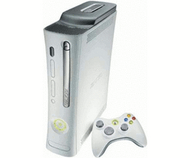
Xbox 360 Pro/Premium
Pro/Premium[]
The Pro/Premium was the higher end bundle, costing around $100 US more than the Core bundle and included a 60GB external hard drive.
Several years after the launch of the Pro, a 60 GB version of the console was released on August 1, 2008. A year later the model was discontinued completely.
Core[]
The Core model, being the cheaper out of the two launch variants was originally released in all regions other than Japan. However the variant was eventually released in Japan in 2006, a year after the consoles original release. The Core model also shipped with a wired variant of the Xbox 360 controller rather than the wireless which was shipped with all other models.
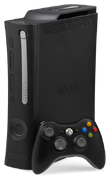
Xbox 360 Elite
Elite[]
In 2007, around two years after the launch of the original Xbox 360 units, a new configuration, the Xbox 360 Elite was released. The Xbox 360 Elite was the more upper classed model and included a 120 GB external hard drive, already connected to the console. Unlike past Xbox 360 consoles, the Elite used a matte black design rather than the usual white/silver.
The price of the Xbox 360 Elite was significantly marked down in 2009 to get rid of stock to make room for newer models.
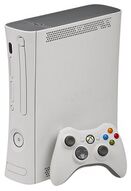
Xbox 360 Arcade
Arcade[]
Some months later in 2007, after the release of the Xbox 360 Elite, the Xbox 360 Arcade was released. The Xbox 360 Arcade acted as a successor to the Xbox 360 Core bundle that was released at the launch of the console. The Arcade only had an internal storage of 256MB, but external hard drives could be purchased to expand the consoles storage.
The Xbox Live Arcade Compilation Disc was also included with all Xbox Arcade models.
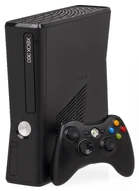
Xbox 360 S
Slim[]
Also known as the Xbox 360 S was a complete hardware revision of the Xbox 360 that was released in 2010. This newer model completely replaced other models available prior to its release, those being the Elite and Arcade. The S was much smaller and compared to past models and a lot quieter.
The Xbox 360 S also included a port dedicated for use with the Kinect which was released several months after the launch of the Slim model.
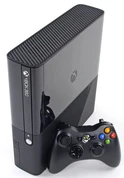
Xbox 360 E
E[]
The final model in the Xbox 360 family was the Xbox 360 E. It was announced and released in 2013, the same year that the Xbox One was released. The E model is once again slimmer than past models and takes most of its designs from the first Xbox One model.
Technical problems[]
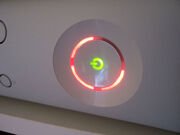
Three red lights on the Xbox 360's ring indicator representing a "General Error requiring service of the Console or Power Adapter", commonly nicknamed the "Red Ring of Death"
The original Xbox 360 model was subject to a number of technical problems. Since its release in 2005, users have reported concerns over its reliability and failure rate.[8][9]
To aid customers with defective consoles, Microsoft extended the manufacturer's warranty to three years for hardware failure problems that generate a "General Hardware Failure" error report. A "General Hardware Failure" is recognized on all models released before the Xbox 360 S by three quadrants of the ring around the power button flashing red. This error is often known as the "Red Ring of Death".[10] In April 2009, the warranty was extended to also cover failures related to the E74 error code. The warranty extension is not granted for any other types of failures that do not generate these specific error codes.
Software[]
Dashboard[]
- See also: Xbox 360 System Software
The Xbox 360's system software is based on a heavily modified version of Windows 2000. According to Wikipedia: This would prove troublesome for Microsoft from multiple directions. For the Xbox division, it made it difficult to bring in other Microsoft applications like Internet Explorer and Silverlight which had to be modified to work on the Xbox software. For Microsoft, the separate fork of these apps for the Xbox 360 and for the versions they were developing for the mobile-based Windows CE environment became difficult to maintain. These complexities led Microsoft towards its "Windows Everywhere" approach c. 2010, reviewing all the dependencies within the desktop, Xbox, and mobile versions of Windows atop the MinWin process and creating a CoreSystem that contained the basic functionality of Windows that could be ported to other systems.
The Xbox 360's original graphical user interface is the Xbox 360 Dashboard; a tabbed interface that features five "Blades" (formerly four blades), and was designed by AKQA. It can be launched automatically when the console boots up without a disc, or when the disc tray is ejected. However, the user may choose to launch a game automatically if a disc is inserted. A simplified version of it can also be accessed at any time via the Xbox Guide button on the gamepad. This simplified version shows the user's gamercard, Xbox Live messages and friends list. It also allows for personal and music settings, in addition to voice or video chats, or returning to the primary Dashboard from the game
As of November 19, 2008, the Xbox 360's dashboard has changed from the "Blade" interface, to a dashboard reminiscent of that present on the Zune and Windows Media Center.
Since the console's release, Microsoft has released several updates for the Dashboard software. These updates have included adding new features to the console, enhancing Xbox Live functionality and multimedia playback adding compatibility for new accessories, and fixing bugs in the software. The latest Dashboard update, revision 2.0.7357.0, was made available on November 19, 2008.
New Xbox Experience[]
- Further information: Xbox Live#New Xbox Experience
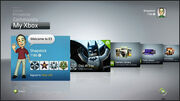
New Xbox 360 Dashboard
At E3 2008, at Microsoft's Show, Microsoft's Aaron Greenberg and Marc Whitten announced the new look Xbox 360 called "The New Xbox Experience". The idea of the update is to allow people who cannot navigate the current Blade GUI, to navigate throughout the console easily. The GUI uses the Twist UI (used in Windows Media Center, Zune). The Blade interface is still used in the new Xbox Guide. The new guide allows the user to do everything he/she could do from the Dashboard itself, whether it's ejecting a disc or browsing the Marketplace, thus making it easier to navigate throughout the system.
As well as a GUI update, many new features have been put into the system's software. Firstly, the update offers the ability to install games from the disc to the hard drive, reducing load times and disc drive noise. However, the game's disc must remain in the system to run its installed version (Similar to The PS2 HD LOADER Feature). A new Community system is also built in, allowing the creation of digitalized Avatars. These Avatars can then be used for multiple activities such as sharing photos or playing Arcade games like 1 vs. 100. The update was released on November 19, 2008.[11]
While previous system updates have been stored on internal memory, this will be the first update to require a storage device. The update requires at least 128MB free space on either a memory card or a hard drive.[12] Microsoft has stated that many Core or Arcade users will not have sufficient space on their limited memory cards for the new update thus providing them with a free 512MB memory card or a discounted 20GB hard drive.[13][14]
Games[]
The Xbox 360 launched with 14 games in North America and 13 in Europe. The console's best-selling game for 2005, Call of Duty 2, sold over a million copies.[15]
Services[]
Xbox Live[]
When the Xbox 360 was released, Microsoft's online gaming service Xbox Live was shut down for 24 hours and underwent a major upgrade, adding a basic non-subscription service called Xbox Live Silver (later renamed Xbox Live Free) to its already established premium subscription-based service (which was renamed Gold). Xbox Live Free is included with all SKUs of the console. It allows users to create a user profile, join on message boards, and access Microsoft's Xbox Live Arcade and Marketplace and talk to other members. A Live Free account does not generally support multiplayer gaming; however, some games that have rather limited online functions already (such as Viva Piñata) and games that feature their own subscription service (e.g. EA Sports games) can be played with a Free account. Xbox Live also supports voice, a feature possible with the Xbox Live Vision.
Xbox Live Gold includes the same features as Free and includes integrated online game playing capabilities outside of third-party subscriptions. Microsoft has allowed previous Xbox Live subscribers to maintain their profile information, friends list, and games history when they make the transition to Xbox Live Gold. To transfer an Xbox Live account to the new system, users need to link a Windows Live ID to their gamertag on Xbox.com. When users add an Xbox Live enabled profile to their console, they are required to provide the console with their passport account information and the last four digits of their credit card number, which is used for verification purposes and billing. An Xbox Live Gold account has an annual cost of US$59.99, C$59.99, NZ$90.00, GB£39.99, or €59.99. On January 5, 2011, Xbox Live reached over 30 million subscribers.
Xbox Live Marketplace[]
The Xbox Live Marketplace is a virtual market designed for the console that allows Xbox Live users to download purchased or promotional content. The service offers movie and game trailers, game demos, Xbox Live Arcade games and Xbox 360 Dashboard themes as well as add-on game content (items, costumes, levels etc.). These features are available to both Free and Gold members on Xbox Live. A hard drive or memory unit is required to store products purchased from Xbox Live Marketplace. In order to download priced content, users are required to purchase Microsoft Points for use as scrip; though some products (such as trailers and demos) are free to download. Microsoft Points can be obtained through prepaid cards in 1,600 and 4,000-point denominations. Microsoft Points can also be purchased through Xbox Live with a credit card in 500, 1,000, 2,000 and 5,000-point denominations. Users are able to view items available to download on the service through a PC via the Xbox Live Marketplace website. An estimated 70 percent of Xbox Live users have downloaded items from the Marketplace.
Xbox Live Arcade[]
Xbox Live Arcade is an online service operated by Microsoft that is used to distribute downloadable video games to original Xbox and Xbox 360 owners. In addition to classic arcade games such as Ms. Pac-Man, the service offers some original games like Assault Heroes as well as games from other consoles such as the PlayStation game Castlevania: Symphony of the Night and PC game Zuma. The service was first launched on November 3, 2004, using a DVD to load, and offered games ranging from US$5 to US$15. Items are purchased using Microsoft Points, a proprietary currency used to reduce credit card transaction charges. On November 22, 2005, Xbox Live Arcade was re-launched with the release of the Xbox 360, in which it was now integrated with the Xbox 360's dashboard. The games are generally aimed toward more casual gamers; examples of the more popular games are Geometry Wars, Street Fighter II' Hyper Fighting, and Uno. On March 24, 2010, Microsoft introduced the Game Room to Xbox Live. Game Room is a gaming service for Xbox 360 and Microsoft Windows that lets players compete in classic arcade and console games in a virtual arcade.
Movies and TV[]
Gallery[]
Trivia[]
- When an Xbox 360 disc is inserted in to a standard DVD or Blu-Ray player, it will show the format of the Xbox 360 disc and/or play a splash screen that says "To play this disc, put it in an Xbox 360 console."
- If an Xbox 360 disc is put in to a PS2, it will also do this, only if the game was released prior to 2010. Otherwise, it will give the Red Screen of Death or the RSOD for short.
See also[]
- Xbox
- Xbox One
- Kinect
- List of Xbox 360 games
- List of Xbox 360 applications
References[]
- ↑ Dybwad, Barb (September 15, 2005). "Xbox 360 launch date is November 22". Engadget.
- ↑ "Microsoft unveils Xbox One next-generation console". BBC (May 21, 2013). Archived from the original on May 22, 2013.
- ↑ "Achievement Unlocked: 10 Years – Thank You, Xbox 360". Xbox Wire (April 20, 2016). Archived from the original on February 16, 2017.
- ↑ David Smith (June 2004). "Microsoft Narrowing Down Xbox Successor's Name?". Ziff Davis Media Inc. Archived from the original on 2007-05-17. Retrieved on 2008-07-26.
- ↑ 5.0 5.1 5.2 5.3 Takahashi, Dean (2006-05-01). "Chronology of Xbox History, 2003". Mercury News. Archived from the original on September 22, 2008. Retrieved on 2006-11-02.
- ↑ Becker, David (2003-08-14). "ATI wins bid for next Xbox". CNET. Retrieved on 2008-07-26.
- ↑ "Microsoft Xbox 360 HD DVD Player Officially Discontinued". Gizmodo (February 24, 2008). Archived from the original on October 3, 2021.
- ↑ "Microsoft admit Xbox problems". BBC (July 6, 2007). Archived from the original on October 16, 2009.
- ↑ "Rings of Red". GamesIndustry.biz (May 25, 2007). Archived from the original on October 16, 2009.
- ↑ "Xbox 360 Warranty Coverage Expanded". Microsoft (June 5, 2007). Archived from the original on June 5, 2007.
- ↑ Tom Bramwell (9 October 2008). "New Xbox Experience". Eurogamer. Retrieved on 2008-10-14.
- ↑ http://www.xboxstorageupgrade.com/hh/web/home/hhauthentication.jsp
- ↑ http://www.xboxstorageupgrade.com/hh/web/home/hhauthentication.jsp;jsessionid=96D23E99D79AE34DF9816B2FA069979A?ssLocale=en_US
- ↑ http://lastshepard.wordpress.com/2008/10/14/microsofts-nxe-storage-solution-free-512mb-memory-card-or-20-for-20gb-hdd/ (archived)
- ↑ Snider, Mike (July 11, 2006). "WWII shows no battle fatigue". USA Today. Archived from the original on June 22, 2008.
External links[]
- Official website
- Xbox 360 on Wikipedia
| Consoles and other devices | |
| Development kits | Xbox Alpha Tower I • Xbox Alpha Tower II • Xbox Development Kit • Xbox 360 Development Kit • Xbox One Development Kit |
|---|---|
| Sixth generation | Xbox • Bundles |
| Seventh generation | Xbox 360 • Xbox 360 S • Xbox 360 E • Bundles |
| Eighth generation | Xbox One • Xbox One S • Xbox One X • Xbox One S All-Digital Edition • Bundles |
| Ninth generation | Xbox Series X • Xbox Series S • Brooklin • Ellewood |
| Cancelled | Xbox Prototype • Unreleased Limited Edition Halo Xbox • Xbox Watch |
